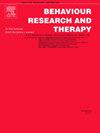Expanding the toolset of experimental Psychopathology: The Trier Social Stress Test induces a personally relevant emotional memory
IF 4.5
2区 心理学
Q1 PSYCHOLOGY, CLINICAL
引用次数: 0
Abstract
Despite the remarkable progress in developing effective psychological interventions for emotional disorders, our understanding of the mechanisms driving therapeutic change remains strikingly limited. To bridge this gap, we need to refine experimental paradigms with high ecological validity and establish their clinical utility. In this study, we replicate and extend previous findings that the Trier Social Stress Test (TSST) can evoke persistent, sensory rich, and personally meaningful emotional memories. One week after the TSST, a student sample (N = 146) reported greater negative valence, arousal, and lack of control in response to TSST-related versus control cues. Participants reported intrusive memories, the content of which reflects the personal relevance, sensory richness, and emotionality of the TSST memory. Re-imagining the TSST through guided imagery evoked heightened emotional responses (skin conductance, heart rate, and self-report) and participants evaluated themselves more negatively due to the TSST. These effects correlated with trait anxiety. However, comparisons to a naïve sample that only experienced the TSST through guided imagery (N = 38) revealed that some findings, including changes in self-image, were not memory-induced. We conclude with concrete examples of how the paradigm can expand our toolset to further unravel mechanistic underpinnings of memory-focused interventions.
扩展实验精神病理学的工具集:特里尔社会压力测试诱发个人相关的情绪记忆
尽管在开发有效的情绪障碍心理干预方面取得了显著进展,但我们对驱动治疗变化的机制的理解仍然非常有限。为了弥补这一差距,我们需要完善具有高生态效度的实验范式,并建立其临床实用性。在本研究中,我们复制并扩展了以往的研究结果,即Trier社会压力测试(TSST)可以唤起持久的、感官丰富的、个人有意义的情感记忆。在TSST测试一周后,一个学生样本(N = 146)报告了对TSST相关线索的更大的负效价、觉醒和缺乏控制。参与者报告了侵入性记忆,其内容反映了TSST记忆的个人相关性、感官丰富性和情绪性。通过引导图像重新想象TSST诱发了更高的情绪反应(皮肤电导、心率和自我报告),并且由于TSST,参与者对自己的评价更加消极。这些影响与特质焦虑相关。然而,与仅通过引导图像经历TSST的naïve样本(N = 38)的比较显示,一些发现,包括自我形象的变化,不是由记忆引起的。最后,我们用具体的例子来说明范式如何扩展我们的工具集,以进一步揭示以记忆为中心的干预的机制基础。
本文章由计算机程序翻译,如有差异,请以英文原文为准。
求助全文
约1分钟内获得全文
求助全文
来源期刊

Behaviour Research and Therapy
PSYCHOLOGY, CLINICAL-
CiteScore
7.50
自引率
7.30%
发文量
148
期刊介绍:
The major focus of Behaviour Research and Therapy is an experimental psychopathology approach to understanding emotional and behavioral disorders and their prevention and treatment, using cognitive, behavioral, and psychophysiological (including neural) methods and models. This includes laboratory-based experimental studies with healthy, at risk and subclinical individuals that inform clinical application as well as studies with clinically severe samples. The following types of submissions are encouraged: theoretical reviews of mechanisms that contribute to psychopathology and that offer new treatment targets; tests of novel, mechanistically focused psychological interventions, especially ones that include theory-driven or experimentally-derived predictors, moderators and mediators; and innovations in dissemination and implementation of evidence-based practices into clinical practice in psychology and associated fields, especially those that target underlying mechanisms or focus on novel approaches to treatment delivery. In addition to traditional psychological disorders, the scope of the journal includes behavioural medicine (e.g., chronic pain). The journal will not consider manuscripts dealing primarily with measurement, psychometric analyses, and personality assessment.
 求助内容:
求助内容: 应助结果提醒方式:
应助结果提醒方式:


